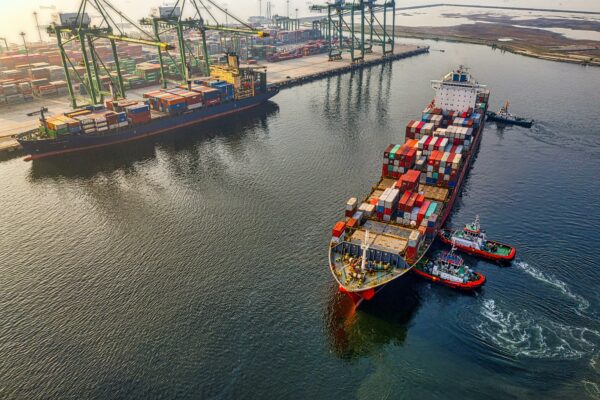Heard of a diversified rates strategy? Here’s how to build one
Aug 08, 2022
Scroll to find out more
Aug 08, 2022
Scroll to find out more

We are all now seasoned professionals when it comes to facing volatility and navigating change. But has the supply chain community considered a new approach?
Inevitably, the continued volatility triggered by a shrinking economy will impact supply chains. We expect to see:
In short, rates have been and will continue to be impacted. It’s hard to ignore
We have seen rates rise almost endlessly in the past couple of years, but just as things had started to stabilise, uncertainty has begun to erode confidence on both sides of the market. This means that it is more important now than ever to design a diversified rates strategy that suits your business and will create stability in the coming months.
But how can you build a supply chain rates strategy that tackles these issues to make your supply chain more resilient and agile?
Here at Zencargo, we collaborate with partners, such as Xeneta, a data-driven freight procurement platform that gives real-time analytics on the ocean and air freight market. Along with the proprietary data pulled from the Zencargo platform, Xeneta allows us to provide customers with data that offers insights into the market and the best rates possible for each shipment.
We spoke with Peter Sands, Chief Analyst at Xeneta, in our latest podcast ‘Freight to the Point’. With over 10 years of experience in procurement, Peter helps customers to make sense of data on the Xeneta platform, answering questions such as ‘what is going on right now?’ and ‘how does that impact my business?’.
But to answer these questions, you first need to sort out your supply chain data. Here are some tips and insights on how you can get the right data to help develop a rates strategy that works for you:
When shipping data is late and unreliable, teams can’t confidently make effective decisions. In fact, inaccurate data can lead to:
Having live rate information can help teams to make effective decisions that can reduce costs and be more resilient to change. It can also allow teams to share data and insights with stakeholders so that business-level decisions can be made effectively, and the entire supply chain is aligned.
Data not only shows stakeholders the reality of the market and how the business is performing, but it can also empower teams by helping them to identify what’s going wrong and how to fix the problem.
So, how do you get good quality data? Here are 3 steps:
Supply chain movements produce an overwhelm of data, and attempting a view over all of this data can cloud the information that can actually help your team make decisions and spot problems.
You need to find the data points that are useful for your business, and funnel through the overload of information. Peter says, “if you scrutinise the original sources, that’s where you find the nuggets that you will need to stay on top of and where you also find out which data sources may not be of core interest to you when making decisions going forward”.
But how do you know which data sources to look at? Here are some things to consider:
Thinking about these questions will not only help you to find the data points that actually matter, but it can also help to build an effective relationship with your freight forwarder. A digital freight forwarder like Zencargo can pull these data points into a centralised platform and showcase this information through data visualisation. This allows you and your team to find the information you need quickly and easily.
Now you have data, and more importantly, the right data, you can use this to start thinking about your rates strategy.
Every business has different needs, and it’s important to think about these needs to make sure your rate strategy is suitable for your business. This could be guaranteeing space, keeping costs as low as possible, moving goods quickly and regularly or shipping less frequently but with larger volumes. Peter says, “the more you know your own business, the better. Because then you can really get into what is essential for you”.
Let’s think back to the questions in the section above. Say your focus is on keeping costs as low as possible, but you also want to guarantee space for your shipments. Peter suggests that if your focus is “100% only to save money” then you might find that “you’re riding the wild spot market constantly”.
However, as we have seen over the past couple of years, the spot market can be unpredictable, with rates reaching unprecedented levels. Spot rates also won’t guarantee space, which could lead to increased costs as you try to get your products onto express airfreight to ensure you get them in time.
So, what do you do if spot rates can potentially be cheaper if rates go down, but could also be more expensive if rates go up AND you are not guaranteed the space you need?
The first step is to establish which products are essential and which are nice to have. Peter suggests that “the goods that you need, the goods that are essential for your business success, those you would probably like to bring into, say, more stable flow, more resilient flow, and you will often get that with a long term contract that gives you a guaranteed shipment and a guaranteed equipment on top of that.”
With the nice to have products, you can play with the spot market to get the cheapest rate and not have to worry about securing space.
To identify what will work best for you, you need a freight forwarding partner that acts as an extension of your team, providing expertise and a diverse network.
Here at Zencargo, we have a team of procurement experts with a wide network to offer businesses consultations that can bring the competitive edge to their supply chain. For example, Anne-Sophie Fribourg, our VP of Ocean Procurement, has over 20 years of experience, a global network and is president of the Maritime Commission within the French Freight Forwarding Association. Anne-Sophie brings knowledge and expertise to help our customers find trends and better understand the market.
Do you need to work on getting the right data and having a clear view of this data? Or do you have the data but are not sure how to approach the market?
The Zencargo platform can improve collaboration, decision making and planning by centralising the data you need. Our expert teams help you to understand this data and use this data to make your supply chain your competitive advantage. You can see our platform in action by joining James Fry, Director of Supply Chain Development, for a product demo!
For a more personalised rates strategy, book a 30-minute consultation with Zencargo’s CCO and Co-founder, Richard Fattal, to discover what options are available and how you can approach the market.

To find out more, book a free consultation with one of our experts today.

If you’re looking for a partner who can support you through 2024, and beyond, w...

Last updated: Monday 3pm BST On Friday 19th July, an unprecedented global issue...